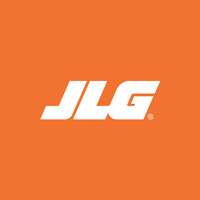 JLG Industries, Inc.
JLG Industries, Inc.
World-leading access equipment manufacturer
____
McConnellsburg, PA
Telehandlers are one of the most versatile pieces of equipment on the job site. They can be used to move materials in a variety of applications, from residential landscaping to commercial construction projects.
“Telehandler” is a combination of the words “telescopic” and “handler,” which precisely describe what this kind of machine does: It lifts, transports and places items around a job site. Specialized attachments further diversify their function, allowing telehandlers to be used for specific job tasks, like setting trusses or handling large pipes.
“What’s the difference between a telehandler and a forklift?” is a common question we receive, and OSHA provides an answer. OSHA identifies seven classes of forklifts, with telehandlers falling into Class VII rough terrain forklifts. The biggest distinction between a standard forklift and a telehandler is the telehandler’s telescoping boom.
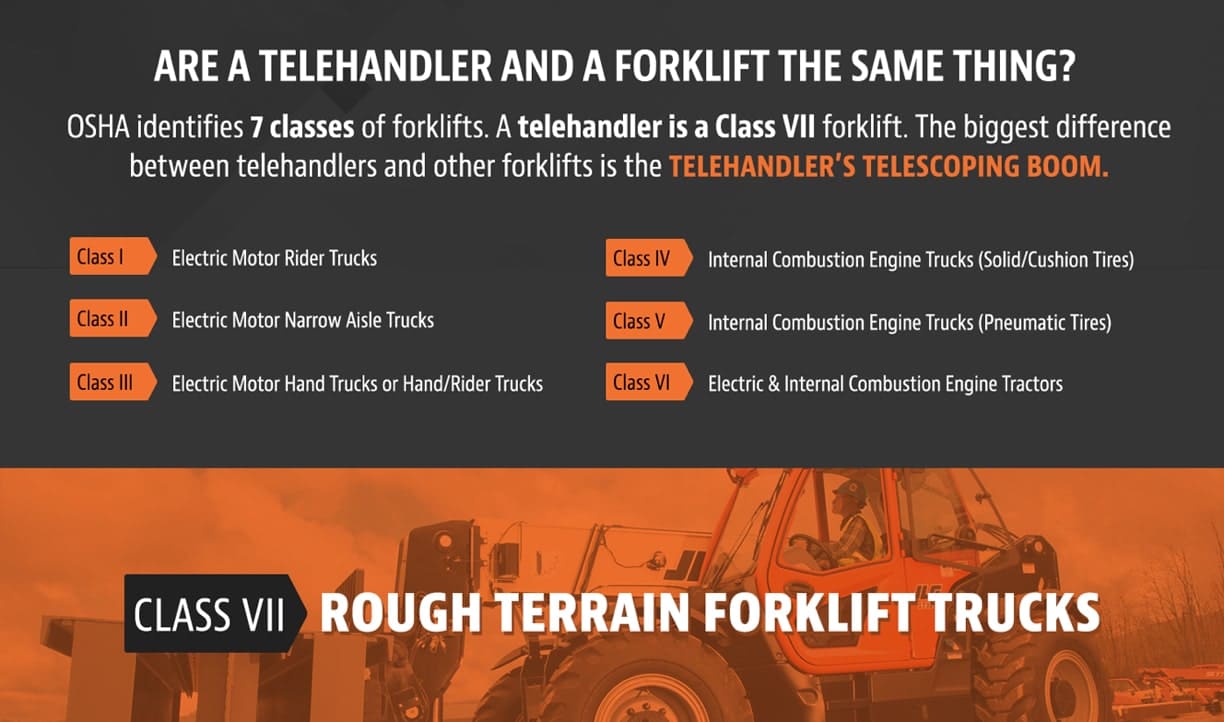 Download our infographic, Telehandler Basics: What You Need to Know Before Buying or Renting a Telehandler, to learn more.
Download our infographic, Telehandler Basics: What You Need to Know Before Buying or Renting a Telehandler, to learn more.
How to Choose a Telehandler to Rent or Buy
There are a wide variety of telehandler capacities, lift heights and attachments available, so understanding your job’s specific needs is key. Before you start looking for a machine to rent or buy, there are several important questions you should be able to answer. Knowing the answers to these questions up front will enable telehandler dealers to help you select the right machine.
1. How much do I need to lift?
For many people, this is the deciding factor when choosing what telehandler to rent or buy. Think about the maximum amount of weight you’ll need to lift, then consider a telehandler within that capacity range that can handle slightly more weight than your largest load. This should help your team avoid overloading the machine, which can be dangerous.
Most telehandlers range in capacity from less than 5,000 lb to 12,000 lb, with some high-capacity models having capacities greater than 50,000 lb. Keep in mind that capacities vary depending on boom angle and extension. Consult your machine’s load chart for specifics.
2. How high do I need to place materials?
Maximum lift height is another important factor, especially if you plan to place material from ground level onto scaffolding or into upper floors of an unfinished building. Check the maximum lift height specification to see how high you can lift loads vertically. Lift heights can vary widely, from less than 20 ft to more than 70 ft.
3. How far do I need to reach?
Horizontal or forward reach refers to how far the telehandler boom can extend horizontally and is also a factor when considering your reach requirements. A greater horizontal reach allows materials to be placed further within a structure, reducing the need to move materials after they are placed. This results in improved productivity.
4. How compact is my job site?
While sprawling suburban or rural job sites have plenty of space to move large equipment around, urban areas and crowded job sites may require more compact telehandlers. A telehandler with a tight turning radius still gives you the benefits of using a telehandler, but it also makes it easier to maneuver through tight spaces.
5. What type of telehandler tires are needed for my application?
It’s important to consider your application when deciding which type of tire you need. There are three varieties of tires: pneumatic, foam-filled and solid. Pneumatic, or air-filled tires, provide the best floatation and operator comfort but are less durable than foam-filled or solid tires. Foam-filled tires are resistant to flats, but they can be susceptible to sidewall damage and don’t necessarily increase tire life. Solid tires are the most durable option that provide the best service life, and they are especially useful in applications that require driving the telehandler longer distances.
6. What type of telehandler engine do I need?
With telehandler engines, there’s a wide range of engine horsepower to choose from. But one of the main differentiators between telehandler engines is whether they’re above or below 74 hp. This distinction is the result of emissions regulation—laws put in place to improve air quality by helping to reduce gas and particulate emissions.
Engines that are below 74 hp are in their final stage of emissions regulation, so they rely on a simple system to keep them in compliance. This system requires no added maintenance, additional fluids or operational changes. Typically, this size engine delivers enough horsepower for general construction tasks and routine rental applications.
Above-74-hp engines have an additional system that requires routine maintenance to remain in compliance with current regulations. The tradeoff is that these machines provide more power and performance, with the ability to climb steeper grades, travel farther and carry larger loads.
7. What specific telehandler attachments will help me tackle the jobs to be done?
Switching up your telehandler attachments lets a single machine be used for more tasks on the job site. Attachments exist for moving sheet material, hauling pallets, setting trusses and even dumping trash. Understanding how you plan to use the machine is the first step to choosing an attachment that will make your telehandler work even better for your application.
Consider how these highly specialized telehandler attachments might improve your productivity.
Sheet Material Handler
Helps you efficiently place sheet material in windows and other entry points.
Watch Video
Tire Handler
Reduces or eliminates the manual labor involved with tire mounting, removal and handling.
Watch Video
Pipe Grapple
Allows you to efficiently handle multiple pipes or a larger single pipe.
Watch Video
Fork-Mounted Extendable Truss
Enables you to lift and place objects when erecting metal buildings, setting wooden trusses and more.
Watch Video
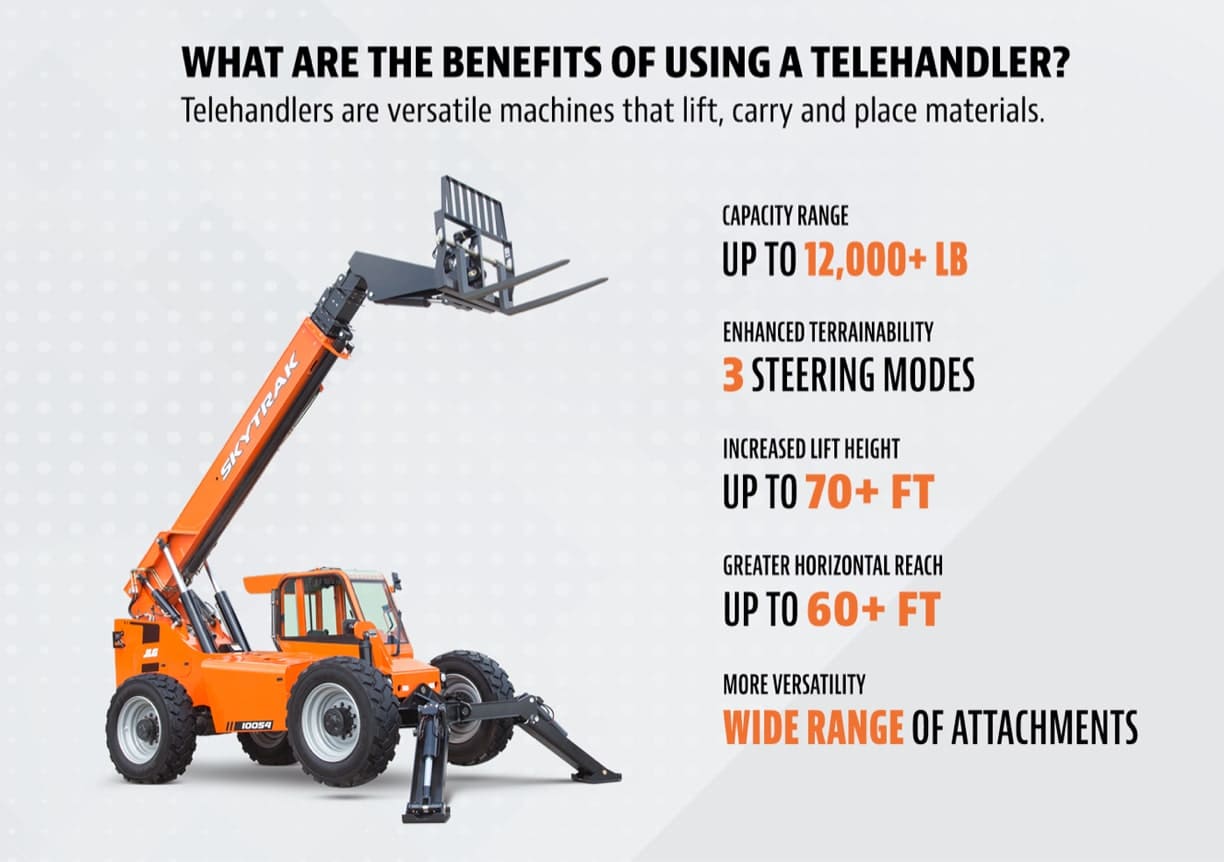 Learn more about telehandler capabilities in our Telehandler Basics infographic.
Learn more about telehandler capabilities in our Telehandler Basics infographic.
What can a Telehandler be Used For?
Buying or renting a telehandler gives you the power, reach and lift height you need to tackle a variety of jobs. Explore the industries where telehandlers can be used below.
General, Commercial & Industrial Construction
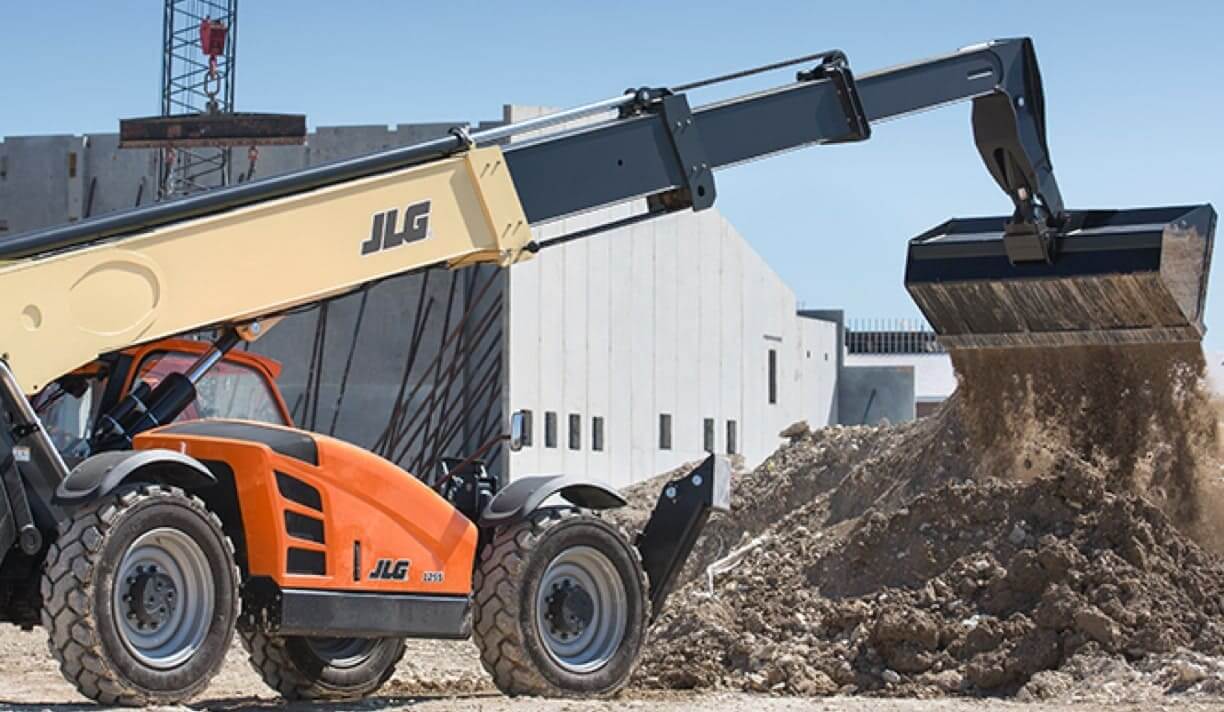 Main Uses in This Application
Main Uses in This Application
- Placing loads precisely at greater heights
- Handling bulky items, like pipes, trusses and beams
- Moving heavy, palletized loads of masonry and sheet material
- Completing steel erection and framing
Recommended Telehandler Attachments
- Pipe grapple
- Sheet material handler
- Lifting hooks
- Forks and carriages (standard, swing, etc.)
Machine Spotlight: JLG® 1075
This 10,000-lb telehandler offers an eight-story lift height that reduces or eliminates the need for costly cranes. Its 30-ft up-and-over reach enables more precise load placement when setting HVAC units, while its 60-ft horizontal reach allows materials to be placed where they’re needed within a structure, resulting in less material rehandling.
Energy Industry Construction & Maintenance
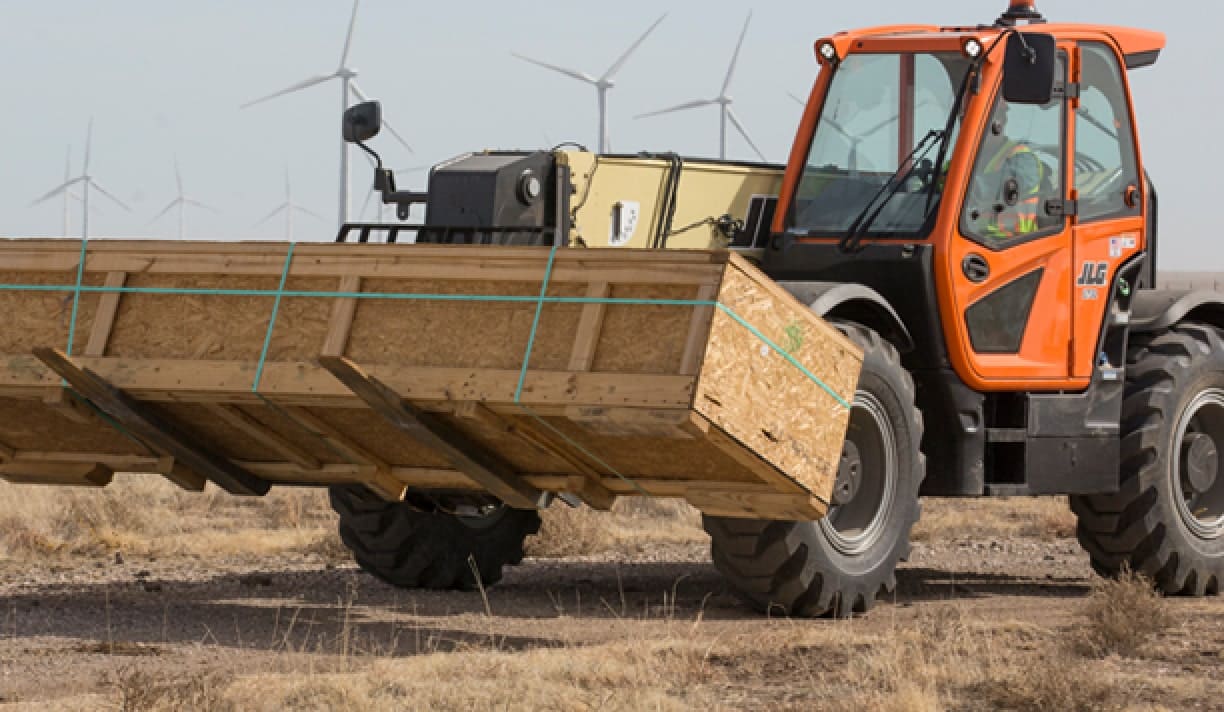 Main Uses in This Application
Main Uses in This Application
- Tackling heavy pick-and-carry applications
- Moving materials farther distances
- Completing equipment maintenance
Recommended Telehandler Attachments
- Forks and carriages (standard, swing, etc.)
- Tire handler
- Pipe grapple
Machine Spotlight: High Capacity JLG® 1732
This model is the highest capacity JLG® telehandler available. With the ability to lift more than 16,000 lb, a maximum lift height of 31 ft and optional SmartLoad technology, this high capacity machine helps you tackle tough energy sector jobs with confidence.
Agriculture & Farming
 Main Uses in This Application
Main Uses in This Application
- Moving and stacking hay bales
- Handling silage
- Completing general farm maintenance
Recommended Telehandler Attachments
- Bale clamps and spears
- Grapple bucket
- Material buckets
Machine Spotlight: JLG® G5-18A
Thanks to its tight turning radius, this compact telehandler helps you maneuver through tight spaces and narrow barn aisles. It’s also compatible with a universal skid steer coupler that makes it compatible with existing skid steer attachments.
Residential Construction
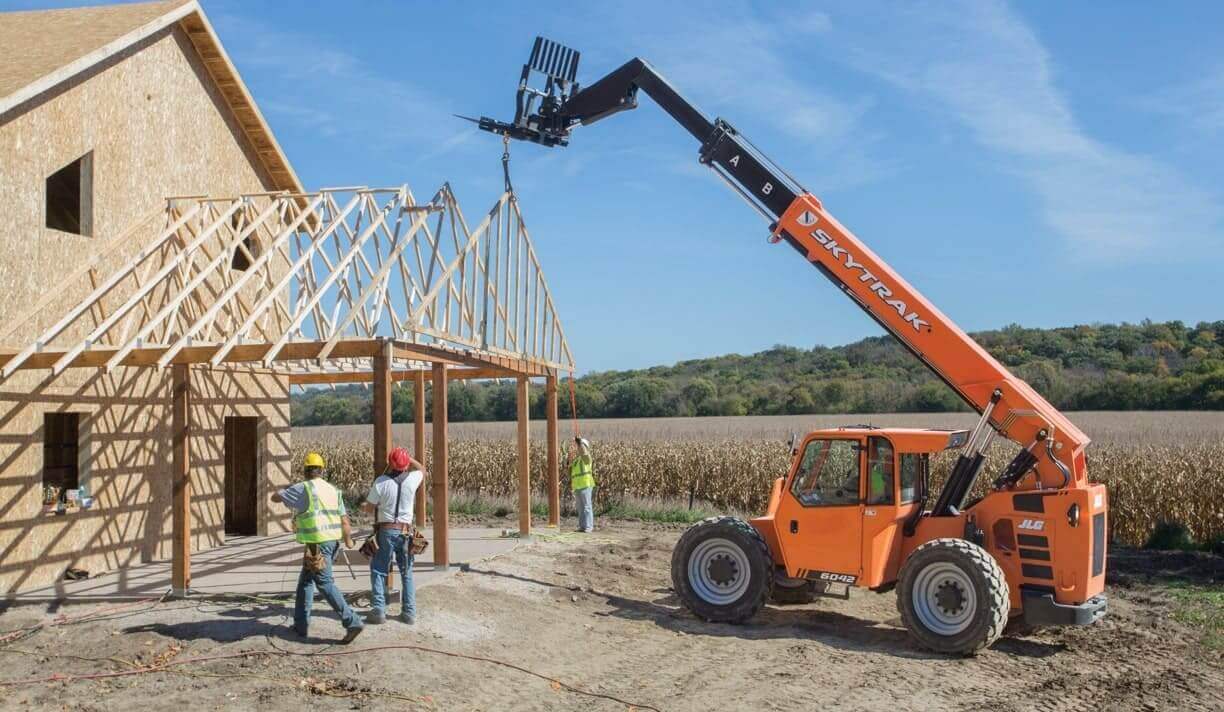 Main Uses in this Application
Main Uses in this Application
- Roofing
- Setting trusses
- Placing roofing material
- Handling sheet material
Recommended Telehandler Attachments
- Truss booms
- Forks and carriages (standard, swing, etc.)
- Material handling arm
Machine Spotlight SkyTrak 6042
This 6,000-lb telehandler helps you maximize productivity during demanding applications while lowering your total cost of ownership. For increased operator comfort, it features an integrated arm rest, optional air conditioning and an intuitive single joystick that controls all boom functions.
Landscaping
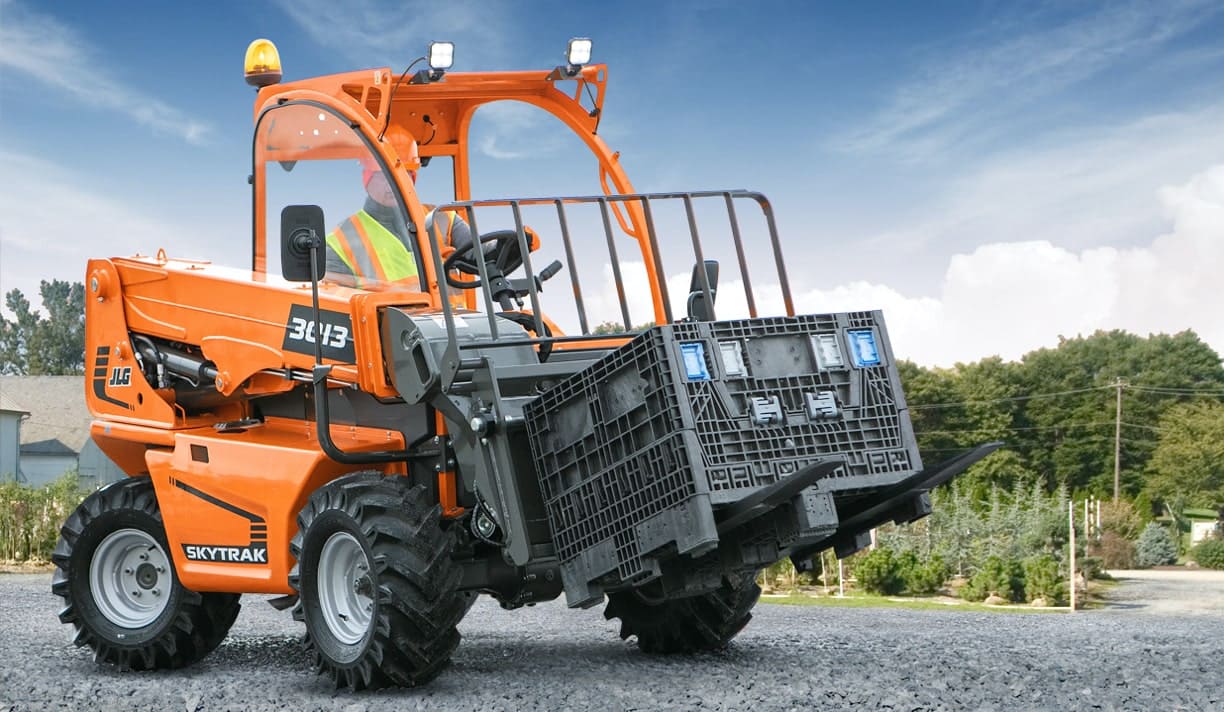 Main Uses in This Application
Main Uses in This Application
- Moving pallets of materials, like fertilizer, pavers and bricks
- Transporting loads of mulch, stones and soil
- Loading and unloading materials from a flatbed or other truck
Recommended Telehandler Attachments
- Material buckets
- Forks and carriages (standard, swing, etc.)
Machine Spotlight: SkyTrak® 3013
This ultra-compact telehandler can be used in place of a skid steer to give you more reach, greater lift height, increased up-and-over reach and enhanced terrainability. But it also fits on a standard trailer, so it can easily be transported between landscaping jobs.
Explore More Telehandler Sizes and Types
Find a telehandler that can handle the demands of your job, whether you need a premium, high-capacity telehandler, a value-based workhorse or a compact machine. Learn more about choosing the right telehandler when you download our infographic,Telehandler Basics: What You Need to Know Before Buying or Renting a Telehandler.
Or, if you’re ready to find a telehandler near you, try our sales and service locator.
Want to stay up to date with industry news and trends similar to this? Make sure you subscribe below to receive monthly updates from Direct Access with newly posted content, so you never miss important information.